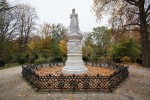- #DE02
- Straße des 17. Juni 10785 Berlin, Germany
- Working hours*:
Always accessible - Prices*:
FREE - * - opening and closing times as well as entrance prices, are subject to alterations without notice. Visitors are advised to check before visiting.
- 52.5140690, 13.3619300 Copy to clipboard Copy
-
#Family time , #Parks
For Berliners, Tiergarten Park is the city’s green lung – just like New York’s Central Park or London’s Hyde Park. Close to the city centre and bordering such major sights as the Brandenburg Gate or Potsdamer Platz, the forested grounds cover a spreading 210 hectares, nearly 519 acres – slightly more than Hyde Park.
Tiergarten Park is very much at the heart of Berlin life – attracting joggers, skaters, cyclists and walkers, as well as those who just want to relax in the sun. The park’s spreading green lawns are popular for family picnics, ball games or simply unwinding and taking it easy – an ideal place to recharge your batteries on a break from some serious shopping or seeing the sights.
From royal hunting ground to public park
In the late seventeenth century, Friedrich III, then Elector of Brandenburg and Duke of Prussia, turned the former royal hunting grounds just outside the city into a “park for the pleasure of the general population”. Since then, Tiergarten Park has been re-designed a number of times, most substantially between 1833 and 1838. In this major makeover, Peter Joseph Lenné, Prussia’s leading landscape gardener, drew his inspiration from English models to transform the grounds and give the park the shape it still has today.
Tiergarten Park was badly damaged during the Second World War, especially in the fierce fighting around Berlin in the last year of the war. But it also suffered dramatically in the wake of the war. Facing an acute lack of coal in winter 1945/6, Berliners cut down what was left of the park’s trees as fuel, nearly deforesting the entire area. Tiergarten Park was replanted with trees from 1949, largely thanks to the many donations of trees from across Germany.
Memorials, the English Garden and a beer garden by a lake
Tiergarten Park not only offers winding tree-lined paths and open green spaces, but is also home to many interesting memorials as well as cultural and political sights. Close to the Brandenburg Gate, you can find the Soviet war memorial and the Global Stone peace project. Further on into the park, the arts and exhibition centre Haus der Kulturen der Welt is set attractively on the banks of the River Spree. The Office of the Federal President adjacent to Bellevue Palace, the official residence of the President of Germany, is to the west. Here too, you can find the Victory Column (Siegessäule) with its panoramic views of the city.
The Tea House, with its attractive terrace and views of the landscaped parkland, is also nearby.
For a waterside location, the Café am neuen See to the south is set on the shore of a small lake. The café’s beer garden is open almost all year round – and if it’s too cold to enjoy sitting outside, you can warm yourself by the fire indoors. From here, it’s only a short walk to the German Resistance Memorial Centre or the memorials for political activists Karl Liebknecht and Rosa Luxemburg.
The sound of music in the park – every Sunday in summer!
Summer visitors to Tiergarten Park on a Sunday might well hear the sound of a rather unusual musical instrument – the bells played by a carillon. Built close to today’s Haus der Kulturen der Welt, the carillon in Tiergarten Park was opened in 1987 as part of Berlin’s 750th anniversary celebrations. The tower, which soars 42 metres high, has 68 bells – making it the world’s fourth largest carillon.
Open-air gas lantern museum
Once Berlin’s streets were lit with gas lanterns – and in some areas, they still are. To commemorate this historical form of street lighting, an open-air museum was established close to Tiergarten S-Bahn station in 1978. Today, the collection, which is permanently open to visitors, comprises nearly 100 gas lanterns from Berlin and other cities. When dusk falls, the lanterns are switched on, lighting up the paths in the park with their soft yellow light.




